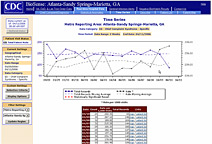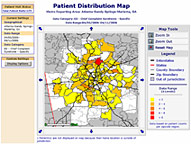
For Hospitals
About BioSense
BioSense's Value to Hospital and the Healthcare Community
Clinical Data of Interest
BioSense Data Sources
Confidentiality and Security
BioSense is a national program that provides real-time biosurveillance and health situational awareness for public health through use of existing data from healthcare organizations.
BioSense’s Vision
The BioSense vision is:
- To provide state, local, and nationwide health situational awareness for suspect illnesses, cases of disease, and to provide a window into the community before, during, and after a health event using biosurveillance.
The approach to achieve this vision includes:
- Supporting real-time delivery of healthcare data to BioSense from hospitals, laboratories, ambulatory settings and other health data sources
- Providing electronic “views,” analytics, and reports for national, state, and local public health, and contributing healthcare organizations
Here are two examples of "views" available in the BioSense application. (Click to enlarge.)
BioSense's Value to Hospitals and the Healthcare Community
BioSense can be beneficial for healthcare facilities by:
- Providing a window on community health status, by using existing data for public health purposes;
- Reducing information that needs to be relayed via phone calls to local public health;
- Providing access to BioSense analytics and surveillance reports;
- Providing funding which is available to advance hospital technical activities needed for standards-based data extraction, transmission, and linkages;
- Supporting interoperability with local public health, and advancing the development of local or regional electronic health record activities;
- Utilizing CDC’s ability to provide local data from national data.
These are the types of primary data that CDC is interested in receiving for BioSense:
- Foundation: demographics, chief complaint, discharge, diagnosis, disposition, hospital utilization;
- Clinical: vitals, triage notes, physician working diagnosis;
- Laboratory: orders, microbiology results;
- Pharmacy: medication orders, dispensed;
- Radiology: orders, interpretation results;
The abridged Data Elements of Interest document can be viewed here.![]()
BioSense uses the data it receives to help identify and characterize naturally occurring bioterrorism events or disease outbreaks.
Real- Time Data Transmission
Most real-time are currently available from large multi-hospital systems, local hospitals, state and regional syndromic surveillance systems, and LabCorp order information.
Non Real-Time Data Transmission
The three data sources which do not currently transmit data in real-time are Department of Defense (DoD) military treatment facilities, Department of Veterans Affairs (VA) treatment facilities, and Laboratory Corporation of American (LabCorp) test orders. These data are received and analyzed on a daily basis. Both the DoD and VA provide ambulatory care data in the form of ICD-9-CM diagnosis codes and CPT medical procedure codes while LabCorp provides test orders and ICD-9-CM codes associated with the reason for the orders. All data sources include additional information with each record such as patient age, gender, zip code of residence, and facility identifier and zip code.
Data Source Statistics
As of May 2008, BioSense has 563 facilities transmitting real-time data to BioSense from health systems and state health organizations. In addition,
DOD facilities list download (updated monthly).
LabCorp test orders information (navigate to Numerical Index to look up test codes)
![]() Maps of BioSense average weekly volumes for DoD and VA ambulatory care clinics and LabCorp
Maps of BioSense average weekly volumes for DoD and VA ambulatory care clinics and LabCorp
BioSense and HIPAA
The privacy and security measures utilized by BioSense facilitate compliance with various Federal laws and/or regulations, including: Privacy Act of 1974, Health Insurance Portability and Accountability Act of 1996 (HIPAA), Federal Information Security Management Act of 2002 (FISMA), E-Government Act of 2002, and Homeland Security Presidential Directive (HSPD) -12.
Securing Privacy
As a public health authority, CDC has specific exclusions from HIPAA regulations. However,
we are sensitive to hospital and public health concerns over issues of privacy and confidentiality and have taken precautions to ensure all data are transmitted securely. All obvious patient identifiers and information are removed from data before it is transmitted to BioSense. Some demographic data are transmitted as needed for epidemiologic and geographic analyses, such as five digit zip codes. No obvious identifiers such as name, address, social security number or medical record numbers are transmitted to CDC.
Each record in BioSense is given a unique identifier which is generated at the healthcare facility. Each healthcare data source then keeps an index of BioSense identifiers and patient identifiers. If the local or state public health department needed to do a follow-up investigation with an individual patient, the health department would have to get that information from the healthcare facility.

